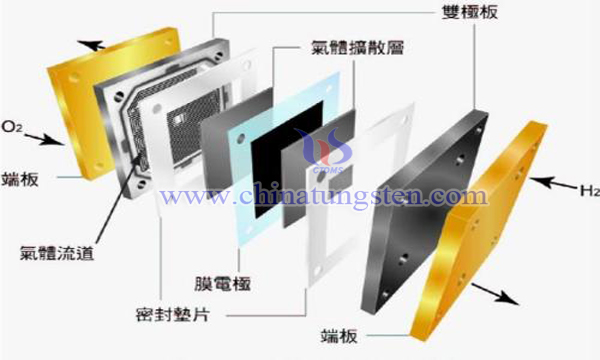Phosphotungstic Acid - Polyvinyl Formaldehyde Composite Proton Exchange Membrane
- Details
- Category: Tungsten Information
- Published on Sunday, 07 July 2019 17:37
Proton exchange membrane fuel cell (PEMFC) is considered as one of the most promising clean energy sources because of its high energy efficiency and non-pollution. PEMFC directly converts the chemical energy of fuel and oxidant (O2) into electric energy, which is a new type of power generation device.

As the core material of fuel cell, proton exchange membrane (PEM) plays the role of conducting protons (H+) selectively from the anode to the cathode, while it blocks fuel and oxidants. The performance of proton exchange membranes determines the performance of fuel cells.
In order to solve the problem of high production cost and low stability of existing proton exchange membranes, the researchers used phosphotungstic acid-polyvinyl formaldehyde composite proton exchange membranes. The preparation methods are as follows:
1.Polyvinyl alcohol formaldehyde with a condensation degree of 45% was dissolved in a mixture of 100 g methanol and water to prepare polyvinyl alcohol formaldehyde solution, the volume ratio of methanol to water was 1:9, and the polyvinyl alcohol formaldehyde solution was heated to 100 ℃ and stirred for 10 hours.
2.Cooling the above solution to 40 ℃, adding 3.5 grams of sodium tungstate and 1.5 grams of concentrated phosphoric acid with a mass percentage of 85% to the solution, then heating the solution to 100 ℃, stirring for 5 hours, then cooling naturally to obtain the pouring solution.
3. The composite proton exchange membrane of phosphotungstic acid-polyvinyl formaldehyde was obtained by pouring solution on glass plate and controlling the film thickness on glass plate to 200 microns, vacuum drying for 24 hours and vacuum drying temperature to 70 ℃.
Polyvinyl formaldehyde is a good film-forming material with high strength, stiffness and hardness, and good bonding and chemical stability. Now, polyvinyl formaldehyde is disposed into a solution, and phosphotungstic acid with proton conductivity is added to the solution, or sodium tungstate and concentration of raw material for producing phosphotungstic acid are added. Phosphotungstic acid, added phosphotungstic acid or phosphotungstic acid synthesized from raw materials can improve the proton conductivity of polyvinyl alcohol formaldehyde. The final prepared phosphotungstic acid-polyvinyl alcohol formaldehyde composite proton exchange membrane has good stability and proton conductivity, and the cost of moulding is lower than that of Nafion membrane, which is easy to industrialize.
- Tungsten Oxide Manufacturer & Supplier, Chinatungsten Online: www.tungsten-oxide.com
- Tungsten News & Prices of China Tungsten Industry Association: www.ctia.com.cn
- Molybdenum News & Price: news.molybdenum.com.cn
- Tel.: 86 592 5129696; Fax: 86 592 5129797; Email: sales@chinatungsten.com



 sales@chinatungsten.com
sales@chinatungsten.com